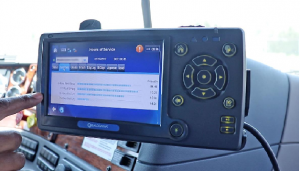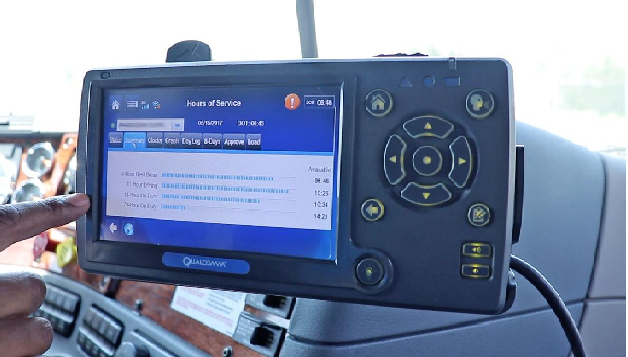Electronic logging device
Electronic logging device Have you ever come across the word ELD? Well, most significant business with big fleets of vehicles employs these technologies to track their fleet better. ELD means Electronic Logging Device. An ELD checks a vehicle’s engine and captures data on whether the engine is running if the vehicle is mobile, its miles driven, and the duration of engine operation. Electronic logging device, or ELDs, are already an integral part of the commercial trucking industry. The technology gives an accurate and simple means of keeping the records that both drivers and operators are required by law to maintain. One such example of an ELD can be found on

ELDs usually replace other recording systems employed by companies. Drivers and fleet operators have used different ways to record the vehicle and the Driver’s information. Previously they used a paper logbook with handwritten entries. Some fleets still use this system, but most are now operating ELDs in their vehicles.
These ELDs are then connected to the vehicle engine providing various data for companies and operators. This information is then uploaded to a system where managers and office personnel can check hour of service (HOS) statuses, generate reports, and produce compliant routes. Businesses can also establish which routes will cost the most fuel and time, identify which drivers require further instruction, and what routes are the best for profit for the company. HOS data can also be shown on the tablet inside the truck so that the Driver can then check it at any time or show it at any roadside inspection.
The information that is captured and transmitted by the ELD includes vehicle identification, motor carrier identification, date, time, geographic location, miles traveled, engine power up and shutdown, yard moves, 60-minute intervals of motion, and engine diagnostics and malfunction.
The ELD also logs the Driver’s information, which includes Driver or authorized user identification, Driver logon/logoff, hours of service (HOS), duty status changes (driving, on duty, off duty), personal use, and certification of Driver’s daily record.
These data are recorded routinely, but some logs can be manually changed or annotated by the driver or maintenance staff. These edits are also tracked and have to be then accepted by the Driver.
ELDs have become necessary due to the U.S. Federal Motor Carrier Safety Administration (FMCSA) encouraging better driving practices in the commercial trucking sector. This also includes oversight of the vehicle’s safety and all of the driver records of duty status. The FMCSA has also ruled that the traditional means used for keeping records — paper logbooks — was not sufficient in meeting the current standards for both safety and accuracy. These logs are prone to mistakes — and gathering, inspecting, revising, and keeping this paperwork is an unnecessary administrative load in the digital age. These are more intended to safeguard drivers from harassment and protect their rights.
The Electronic logging device offer advantages to the agency and fleets or operators — ineffectiveness and usage efficiency. These make the job of keeping logs simpler, quicker, and smarter. With ELDs, Vehicle fleets, and drivers who have made the conversion say that they’d never wish to return to the systems they used before. ELDs have helped eliminate dealing with large amounts of paper. They can then make entries to records in quickly, using the on-screen interface. Many drivers stated that they’d reduced the number of administrative loads they used to have when filling out, examining, and revising logbooks.
Because using ELDs automate much of the process, the possibility of error is decreased, so that drivers and managers spend less time and labor resolving issues with the authorities over disputed entries. ELDs also help speed up and make for straightforward roadside inspections; this translates to more time spent on the road. These Electronic logging device turn to less work for authorities, fleet managers, and ultimately, the drivers.
With access to correct records and automatic accountability, it will now take away some of the pains of recordkeeping. This will also lessen driver fatigue, and it is expected that this will then lower the occurrence of accidents involving commercial vehicles. For fleet administrators, this technology offers an easier task for verifying records.
Using this technology is a good step for the driving industry. Previously, drivers were sometimes under pressure if their records didn’t match the expectations of the companies that they worked for. The devious actions of these few companies reflected badly on the others. With this technology, records cannot be changed without a record of when they were broken and by whom.
This new technology also now allows trucking, a particularly sluggish trade when it comes to technology, to gain from statistics and insights that aren’t easy to get on a paper log. For instance, ELDs allows drivers and companies to track how long they’ve been queuing at a wharf, and guarantee that the Driver is compensated for the time spent at the wharf. On average, only around 3% of drivers who are kept waiting at docks said they received payment from the shipping companies.
According to the FMCSA website, the ELD rule applies to motor carriers and drivers who are required to keep records of duty service (RODS). With ELD, authorities can quickly review a driver’s hours of service by viewing the ELD’s display screen, by a printout from the ELD, and by retrieving data electronically from the machine. Manufacturers must then self-certify that their ELDs meet standards in the ELD rule and then register with the FMCSA. Motor carriers and their drivers must select only ELD machines that are certified and duly registered with the FMCSA, as some other devices may still not be compliant.
This mandate about this ELD Standard is also grounded on a previous regulation for electronic on-board recording devices (EOBR) previously published but then recalled. The rule applied to fleets that had grave HOS compliance issues, but not all vehicles were subject to the tracking requirements. It was then eventually seized over worries that carriers could abuse the devices to harass their drivers – something the new ELD rulings must address. While there are differences among ELD, AOBRD, and EOBR devices, they share some similar elements. They could track a driver’s HOS electronically. They need to be synchronized with the vehicle’s engine, ensuring drive segments are recorded. They will usually pass data to a system where personnel can see logs on an almost real-time basis, ensuring everyone to be on the same page.
Electronic logging device In today’s commercial truck and fleet operations, ELDs installed in these motor vehicles can monitor and log data about the vehicle and its Driver that go beyond the usual RODS — from Driver Vehicle Inspection Reports and IFTA automation to behaviour tracking on speeding, idling, and hard braking.
